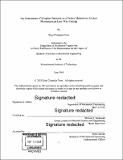An assessment of stingless beeswax as a pattern material in ancient Mesoamerican lost-wax casting
Author(s)
Pitses, Eleni Chrisoula
DownloadFull printable version (4.457Mb)
Other Contributors
Massachusetts Institute of Technology. Department of Mechanical Engineering.
Advisor
Michael J. Tarkanian.
Terms of use
Metadata
Show full item recordAbstract
Metal objects were of great cultural significance in pre-Columbian Mesoamerica. Historical and archaeological evidence prove that these items were made by the process of investment casting, or "lost wax" casting, by which a wax model of the object is created, and a ceramic mold is built around it. The wax is melted out to allow for the pouring of the molten metal. Considerable research has focused on the alloy composition of these objects, and some research has been done on the ceramic molds, but little is known about the composition, source, and manufacture of the wax itself. This paper builds upon work by Michael Tarkanian and Dr. Elizabeth Paris, attempting to fill this gap in the literature. Spanish written accounts of ancient Mesoamerican casting processes mention that wax from stingless bees was mixed with copal, or tree resin, and used to form the models for lost-wax casting. Waxes from Mexican stingless bees Melipona beecheii, Scaptotrigona pectoralis, and Melipona yucatanica were considered in this study, in addition to three copals: Bursera copallifera, Protium copal, and Pinus contorta. Thermal data from Differential Scanning Calorimetry revealed no changes in thermal behavior between waxes and their blends with copals, showing that none of the blends considered in this study are miscible. However, hardness testing revealed that the blends of Pinus contorta with Melipona beecheii and with Melipona yucatanica were harder than their respective waxes. This is in line with a Spanish account of the casting process, which mentions that copal was added so the wax may "[become firm and] harden well". Including data collected by Tarkanian and Paris, the most favorable material for investment casting would be Friesomelitta nigra wax mixed with Bursera copallifera, according to the criteria considered in this study.
Description
Thesis: S.B., Massachusetts Institute of Technology, Department of Mechanical Engineering, 2018. Cataloged from PDF version of thesis. Includes bibliographical references (pages 43-45).
Date issued
2018Department
Massachusetts Institute of Technology. Department of Mechanical EngineeringPublisher
Massachusetts Institute of Technology
Keywords
Mechanical Engineering.